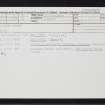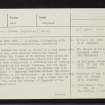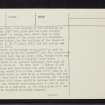Monymusk Priory
Priory (Medieval)
Site Name Monymusk Priory
Classification Priory (Medieval)
Alternative Name(s) Priory Of Monymusk
Canmore ID 18053
Site Number NJ61NE 8
NGR NJ 6855 1528
Datum OSGB36 - NGR
Permalink http://canmore.org.uk/site/18053
- Council Aberdeenshire
- Parish Monymusk
- Former Region Grampian
- Former District Gordon
- Former County Aberdeenshire
NJ61NE 8 6855 1528.
See also St Mary's (Parish) Church (at NJ 6850 1524), NJ61NE 4.
For stones possibly from the priory at House of Monymusk, see NJ61NE 5.00.
For discovery of reliquary (at NJ 6888 1545), see NJ61NE 5.01.
(NJ 6855 1528) A priory, originating with Culdees and later becoming Augustinian, existed at Monymusk.
The Culdees are first on record in a land grant of 1130. By 1211 they were calling themselves Canons Regular, to which the Bishop of St Andrew took exception and in that year a Papal Commision established that the Culdees would have a dormitory, a refectory and an oratory with burial right in the parish cemetery, but 'it shall never be lawful for the same Culdees to profess the life or order of monks or canonical brethren without the assent of the same Bishop or his successors'. By 1245 this assent had apparently been given as in that year a Papal bull is addressed to 'the prior and convent of Monymusk of the order of St Augustine'.
Until the 16th century the history of the monastry is obscure but by 1558 'the place and religion thereof (were distroyit' it having been burnt down in 1554 through the negligence of the prior and his servants. The ruins were robbed for the building of the House of Monymusk (NJ61NE 5) about 1587, and the priory was securalised in 1617.
Vague traces of buildings could still be seen in 1722 about 20yds NE of the church (Macfarlane 1906-8) but the foundations are said to have been dug up about 1726, though there may have been some remains at a slightly later date.
There seems to be a general agreement that part of the buildings stood at NJ 6855 1528 (about 40yds NE of the church and just within the gate leading to Monymusk House) where lies a flat stone 4'11" long by 2' maximum breadth which is said to be a threshold, and two pillows have been built to mark its position, but Simpson (1943) points out that
this stone exhibits various bolt sockets and a leaden bar clearly indicating that it has at one time been used as a gatepost, so its connection with the priory must be regarded as a highly suspect.
The plan of the priory buildings is not known nor is it certain whether the parish church (NJ61NE 4) rather than a private chapel, served the convent. This is thought probable as it was a common arrangement that Augustinian convents should use the chancel of the parish church while the nave served the parish. This might explain the extraodinary length of the chancel of the parish church.
M MacPherson 1895; W Macfarlane 1906-8; W D Simpson 1925; W D Simpson 1943; D E Easson 1957 .
There is no trace of the priory. The 'flat stone' and 'two pillars' at NJ 6853 1527 are modern and, as Simpson suggests, not connected to the priory.
(Undated) information in NMRS.
Trial excavation was carried out by I Mate (SDD, CEU), August 1981.
(Newspaper reference cited).
NMRS, MS/712/56.














